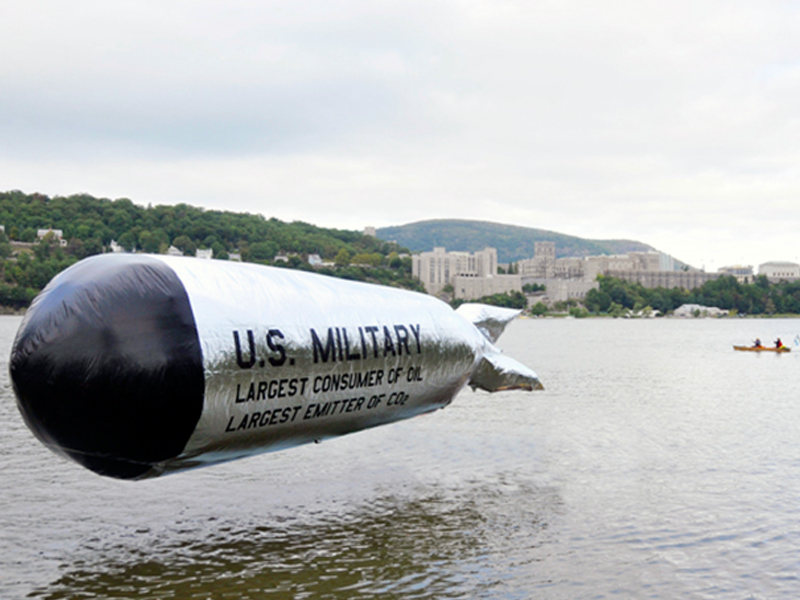The Carbon Bomb – Inflatable Sculpture Direct Action
Project Description
Inflatable sculptures were not an artistic medium that was familiar to me however it was one that held great interest in terms of its storytelling capabilities. Bouncing around New York building and deploying these large sculptures with Tools For Action was an amazing opportunity to build friendships and learn this discipline during the lead-up to the People’s Climate March.
After a night of driving late, the morning welcomed us to the ground moving and the sound of early morning trains next to the tracks where we camped. Our appointment to our location required reservations for the space. Under the guise of a wedding photo shoot, we spent the morning inflating many large balloons and stuffing them into the large Carbon Bomb. Other anti-war organizations helped deploy this installation via canoes above the river using ropes in order to frame it for the desired photo.
This friendship would extend to Paris COP21 when there was still naivete of the fact that these large global mobilizations require massive amounts of fossil fuels to travel around the world to never challenge any power or create any change.
On the morning of September 12, 2014, a 30-foot carbon bomb blew up over the Hudson River in front of West Point Military Academy. An inflatable bomb pressurized with carbon dioxide, hydrogen, and oxygen contained in an outer shell of silver radiant barrier foil, the carbon bomb was manufactured as part of a research program coordinated by the inflatable fabrication group Tools for Action. The lettering on the side of the bomb read, “US Military: Largest consumer of oil, largest emitter of CO2.”
As the United Nations prepares to meet in New York on September 23 to discuss climate change, one subject that will not be on the negotiating table is the emissions of the US military. Although the US military is assumed to be the largest emitter of CO2, the military is not required to report their emissions to the UN. While the Pentagon refuses to release fuel usage data, it has been estimated that the US military is responsible for five percent of total global greenhouse emissions.
“In the dialogue around stopping climate change, too much emphasis is being put on ethical consumerism,” said Katherine Ball of Tools for Action. “Does it really matter if we try to fly less if the US Air Force continues to burn one-fourth of the world’s jet fuel? We have to address the systemic causes of climate change: the most eco-friendly thing you can do is be anti-war.”
For decades, the US military has been fighting wars to secure oil resources. These wars have taken many forms: from the CIA-planned coup in Iran in 1953 in order to prevent the newly elected prime minister from nationalizing the nation’s oil, to the full-scale invasion of Iraq in 2003 in order to – among other things – up the production of Iraq’s vast oil fields.
In the process of fighting these oil wars, the US Department of Defense has consumed more energy and emitted more carbon than any other institution on Earth. In 2003, as the military prepared for the Iraq invasion, the Army estimated it would consume more gasoline in only three weeks than the Allied Forces used during the entirety of World War II. The Guardian estimates that throughout the entire Iraq War, the US military’s carbon footprint was between 250-600 million tons.
“Military interventions for oil are just the tip of the iceberg. The military is gearing up to fight ‘climate wars’ over resources destabilized by climate change: water, arable land, and food. It is a vicious cycle: In fighting these climate wars, the military will release emissions, which will cause more climate change, which further destabilizes resources and cause more climate wars, which will cause more emissions…” Artúr van Balen of Tools for Action said.
“We are actively integrating climate considerations across the full spectrum of our activities to ensure a ready and resilient force,” John Conger, the Pentagon’s Deputy under Secretary of Defense for Installations and Environment, said in a statement following the 2014 report. Global weapons manufacturers are also planning for these climate wars, predicting that there will be increased demand for their products as climate change accelerates.
Katherine Ball concluded: “Is military force the US government’s plan for dealing with climate change?”
Project Details
Client: Tools For Action
Tags: Direct Action, Environmental, People's Climate March
View Project







